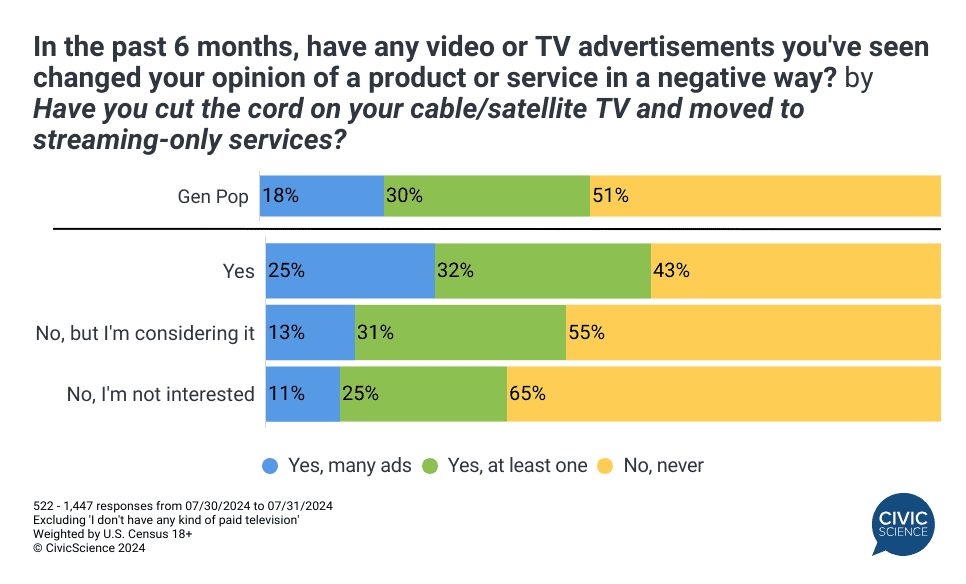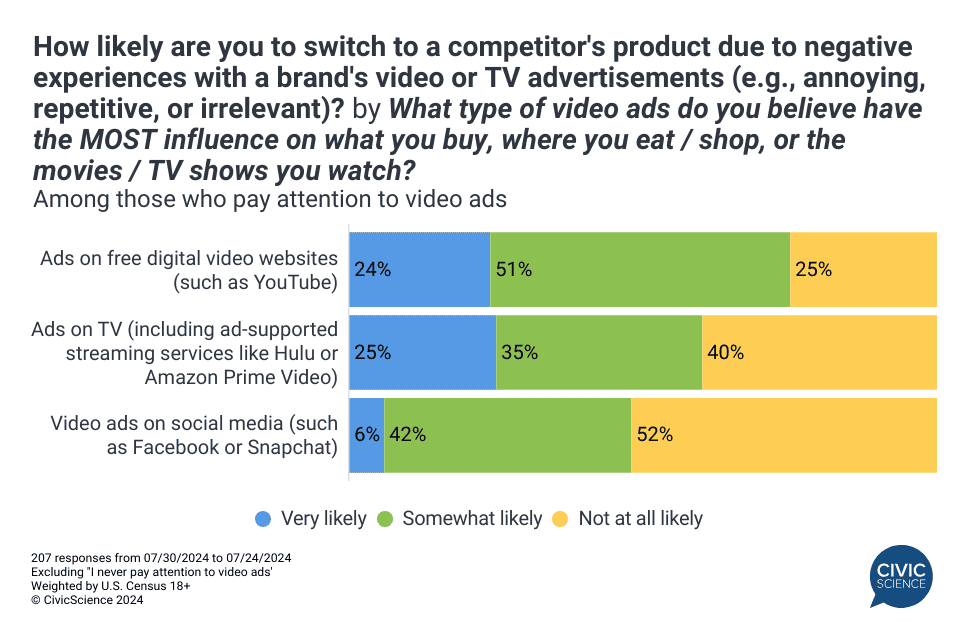This is just a sneak peek at the thousands of consumer insights available to CivicScience clients. Discover more data.
Advertising is a constant effort for brands to stand out and win consumers. Video advertising, in particular, is a highly competitive landscape, with brands spending hundreds of billions globally. However, spending money on ads doesn’t guarantee a positive reception.
How often do Americans say they’ve seen a video ad that has negatively impacted their perceptions of a product or service?
New CivicScience data reveal that nearly half of U.S. adults (48%) said their opinion of a product or service was negatively influenced by at least one TV or video ad in the last six months.
Video ads are even more likely to shift opinions negatively among cord-cutters – 55% of streamers said at least one ad changed their opinion of a product or service in a negative way, including 25% who said ‘many’ ads had a negative impact. On the other hand, two-thirds of those not interested in cutting the cord (those who still watch cable or satellite TV) said no ads had impacted them negatively recently.

Let Us Know: How often are your buying decisions directly influenced by advertising?
Younger adults and cord-cutters are most likely to be swayed into action by negative experiences with ads.
Unsurprisingly, data show that poorly received video ads can have serious consequences for brands. Most consumers are ‘somewhat’ (42%) or ‘very’ (23%) likely to switch to a competitor due to a negative ad experience. Those who had a negative experience with an ad in the past six months were far more likely to switch.
A majority across each age group say they’re likely to switch following a negative experience, led by Gen Z (77%), with adults 55+ the least likely (58%). Cord-cutters and cord-cutting intenders, which skew younger, are equally as likely to switch to competitor brands based on poorly received advertisements. In contrast, less than half of non-cord-cutters are likely to switch brands due to a negative response to an ad.

Even among consumers who say they are ‘very’ loyal to their favorite brands, the majority (67%) are at least ‘somewhat’ likely to switch away from a brand following a negative experience with an ad they saw. Interestingly though, consumers who are ‘not at all’ loyal to brands are the least likely to switch away from a brand because of an ad.
Ads on free video sites that are received negatively are far more likely to be impactful.
When it comes to which type of video ads consumers say have the most influence on their purchasing decisions, TV advertising (including ones seen on ad-supported streaming services), is the convincing leader, followed by social media and ads on free video sites like YouTube.1
However, those who are most influenced by ads on free digital video websites are by far the most likely to switch who they patronize based on a negative experience with a video ad.

Join the Conversation: How often in the past 6 months has an advertisement you saw discouraged you from purchasing from the brand that ran the ad?
Factors like relevance and repetitiveness likely play a key role in whether consumers form a negative opinion toward a given ad. As much as 55% of Americans say the majority of the digital advertising they see is not relevant to them. 2 Additionally, when asked about the acceptable number of times to see a given ad while watching streaming content, 85% said they would prefer to see a particular ad no more than twice, with 42% saying they should only see an ad once. 3
The data highlight how adverse reactions to video advertising can swiftly drive consumers to competitors, especially among younger demographics and cord-cutters. It’s clear that careful targeting, messaging, and uniqueness should be priorities. Want to have a better shot at ads that land positively and create a highly targeted ad campaign that wins?








